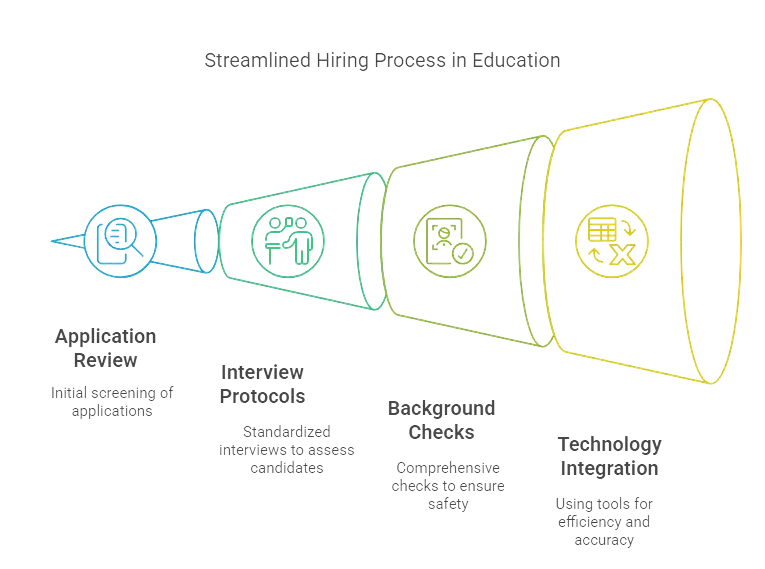The education sector holds a unique responsibility: shaping and safeguarding the minds of the next generation. The hiring process must be rigorous to ensure that only the most qualified and trustworthy individuals are selected for roles involving interactions with students in schools or educational institutions. Every position contributes to creating a safe learning environment. This guide covers important aspects of screening in the education sector, including best practices and legal requirements for hiring.
Key Takeaways
- Thorough screening of school employees is essential for ensuring student safety and preventing incidents before they occur.
- Inadequate screening can jeopardize an educational institution's reputation and result in legal consequences.
- Key components of an effective screening process include background checks, academic verification, reference checks, and drug testing.
- Adhering to legal and ethical considerations, such as confidentiality and equal opportunity compliance, is essential for a fair hiring process.
- Proactively updating and refining screening protocols helps educational institutions maintain a safe and trustworthy environment for students and staff.
Introduction
Safety and integrity in educational settings are non-negotiable. When parents send their children off to school, they entrust educational institutions with both their academic development and personal safety. It is vital to ensure that those who interact with students daily are trustworthy and qualified.
Education sector screening isn't just a formality—it's an essential process that directly impacts student safety and well-being. By screening potential staff, schools can prevent incidents, creating a safe environment for students. It's a proactive measure that reflects the institution's commitment to protecting its learners.
The manual aims to help educational institutions with effective hiring practices, emphasizing student safety. From background checks to academic verifications, we'll walk you through the key components of a robust screening process. Let's dive into the essentials that fortify educational environments and uphold the highest standards of safety and integrity.

Why Education Sector Screening is Crucial
When it comes to the education sector, screening isn't just a formality; it's a linchpin for ensuring a safe, productive atmosphere. Let's break down why thorough screening is non-negotiable.
EXPERT INSIGHT: With every resume I read, every background check I run, I remind myself—it's not about filling seats, it's about protecting futures. We education HR pros have the silent but vast responsibility of ensuring that only those worthy of a child's trust ever set foot in a classroom. It's not a process, it's a guarantee—to families, to students, to society. For it's with the successful hire, we don't merely put bodies in seats, we establish safe spaces for young minds to fully thrive. - Charm Paz, CHRP
Student Safety
First and foremost, student safety is paramount. A secure learning environment isn't a luxury—it's a necessity. Low-quality or insufficient screening has led to unfortunate incidents in the past, placing students at risk. A rigorous screening process ensures that only qualified and trustworthy individuals are entrusted with our youth, safeguarding students' well-being by preventing harmful influences from entering the school system.
Institutional Reputation
Inadequate screening doesn't just put students at risk; it jeopardizes the entire institution's reputation. One adverse incident can ruin years of hard-earned credibility. Parents, communities, and regulatory bodies hold educational institutions to the highest standards, and any failure in this area can result in lawsuits, loss of trust, and a steep decline in student enrollment. Robust screening processes not only mitigate these risks but also demonstrate a commitment to excellence and integrity.
Legal Compliance
Compliance with legal regulations is another critical aspect. Educational institutions operate under strict local, state, and federal guidelines designed to protect everyone involved. From the "Department of Labor" guidelines to state-specific mandates, these rules exist to ensure that hiring practices are fair, thorough, and transparent. By adhering to these mandatory obligations, schools are better equipped to avert legal repercussions and foster a secure environment for students and staff alike.
In summary, rigorous screening protocols aren't just beneficial—they're essential. They form the bedrock of student safety, protect institutional reputation, and ensure legal compliance, creating a trustworthy and effective educational environment.
Key Components of School Employee Screening
When it comes to hiring in the education sector, a robust employee screening process is non-negotiable. Here’s a breakdown of the core components that form the backbone of an effective screening protocol.
Background Checks
Background checks are the first line of defense in ensuring that applicants are suitable for roles in education. This involves a thorough examination of criminal history, past employment, and educational qualifications. Conducting comprehensive background checks can prevent individuals with a history of offenses or unsuitable behavior from entering the school environment. Referencing resources like the Society for Human Resource Management (SHRM), institutions can adopt best practices that cover all essential areas of a candidate's history.
Academic Verification
Validating a candidate’s educational background is crucial. Misrepresented qualifications can lead to hiring underqualified personnel, compromising the quality of education. To avoid this, schools should utilize verification services that confirm the authenticity of degrees and certifications. This step can reveal discrepancies early in the hiring process, ensuring that only candidates with genuine qualifications move forward.
Reference Checks
Contacting previous employers can provide invaluable insights into a candidate’s work ethic, behavior, and suitability for a role within an educational institution. This isn’t just a formality; it’s an integral part of the hiring process. When conducting reference checks, ask specific questions that relate to the candidate’s past responsibilities, behavior with colleagues and students, and overall performance. This helps in creating a more complete picture of the candidate’s capabilities and attitude.
Drug Testing
Drug testing remains a contentious yet necessary component of the screening process. Ensuring that employees are not under the influence of substances that could impair their judgment or performance is vital for maintaining a safe environment. Legal considerations must be taken into account, as laws surrounding drug testing can vary widely. Institutions must stay aware of these differences and implement drug testing in a manner that upholds legal standards and respects candidates' rights.
By integrating these key components into their hiring process, educational institutions can significantly mitigate risks and build a team dedicated to fostering a secure, supportive, and high-quality learning environment.

Internal Protocols and Policies
Defining Clear Screening Policies
When it comes to hiring for educational institutions, having well-defined and consistently enforced screening policies is non-negotiable. This involves carefully outlining the steps and criteria for evaluating potential hires. You’ll want to ensure that your policies specify what types of background checks are required, how reference checks should be conducted, and what levels of past experience or qualifications are necessary.
Transparency is key — make sure applicants are aware of these screening policies upfront. Not only does this set appropriate expectations, but it also adds a layer of trust between the institution and prospective employees. Clear policies help in avoiding ad hoc decision-making, ensuring everyone involved in the hiring process is on the same page.
Training HR Staff
A policy is only as good as its implementation, and here’s where well-trained HR staff make all the difference. HR professionals must be well-versed in the latest screening techniques to ensure that the process is both efficient and thorough. Regular training sessions and workshops can help HR staff stay updated on evolving best practices, technological tools, and changes in legal requirements.
Moreover, make sure HR teams are educated on how to use these screening tools effectively, whether it’s navigating databases for background checks or utilizing software for academic verification. Keep an open line of communication for HR staff to stay informed about any changes in screening laws or institutional policies. The goal is to equip your HR team with the knowledge and tools they need to conduct screenings that are not only thorough but also legally compliant and unbiased.
By setting strong internal protocols and investing in consistent HR training, educational institutions can significantly enhance the quality and safety of their hiring processes. A proactive, informed approach ensures that only the best candidates make it through, ultimately fostering a secure and productive learning environment.
Implementing Effective Hiring Practices
To ensure a robust hiring process in the education sector, it’s vital to develop a structured, streamlined approach that covers every aspect from job postings to onboarding.
Creating a Structured Hiring Process
The foundation of effective hiring starts with clear and detailed job postings. These should outline essential qualifications, required experience, and the specific responsibilities of the role. Potential candidates must understand the expectations upfront, which helps attract the right talent. Once applications are received, a structured screening process can begin. This typically involves initial application reviews, standardized interview protocols, and comprehensive background checks.
Collaborating with External Agencies
One vital component of an effective hiring practice is deciding whether to conduct all screenings in-house or outsource parts to external agencies. Outsourcing can bring several benefits, including access to specialized expertise and advanced screening tools. However, it also entails certain risks, such as potential lapses in communication and increased costs. To mitigate these risks, it’s essential to partner with reputable agencies that have a proven track record in the education sector.
Utilizing Technology
Technology has significantly transformed the hiring landscape. Leveraging modern tools like applicant tracking systems (ATS), background verification software, and automated reference checking can increase both the efficiency and accuracy of the screening process. These technologies streamline workflows, minimize human error, and allow HR professionals to focus on more nuanced aspects of candidate assessment. For instance, digital platforms can cross-check criminal records within seconds, provide real-time updates on academic verifications, and facilitate seamless communication with past employers for reference checks.
By implementing a structured hiring process, considering strategic collaboration with agencies, and harnessing the power of technology, educational institutions can ensure they employ only the best and most trustworthy individuals. This, in turn, fosters a secure, efficient, and conducive learning environment—a win for students, staff, and the entire community.

Legal and Ethical Considerations
Understanding State and Federal Laws
Navigating the intricate web of state and federal regulations is paramount when it comes to screening school employees. Each state may have unique requirements, and it’s essential to stay up-to-date with these laws to ensure compliance. At the federal level, laws like the Fair Credit Reporting Act (FCRA) govern how background checks are conducted. It’s crucial to understand both the broad requirements and the nuances of these regulations to avoid legal pitfalls and guarantee a compliant hiring process. Regular training and an ongoing dialogue with legal counsel can help HR departments stay on top of these changes.
Confidentiality and Sensitivity
Handling candidate information with utmost confidentiality is not just a legal requirement but also an ethical imperative. Schools must have robust policies to protect sensitive information gathered during screenings, such as social security numbers, criminal records, and personal references. Proper data handling protocols and secure storage solutions can prevent unauthorized access and data breaches. Moreover, sensitivity training for HR personnel can ensure that all candidate information is managed respectfully and discreetly, fostering a trustworthy and professional hiring environment.
Equal Opportunity Compliance
Ensuring a fair and unbiased screening process is foundational to any ethical hiring practice. Schools need to establish clear policies that comply with Equal Employment Opportunity Commission (EEOC) guidelines to prevent discrimination based on race, gender, age, disability, or other protected characteristics. Implementing standardized screening criteria and utilizing diverse hiring panels can help mitigate unconscious bias. Furthermore, providing training on implicit bias and regularly reviewing hiring practices for fairness will promote an inclusive and equitable hiring process, supporting a diverse and dynamic educational workforce.
Challenges in Education Sector Screening
Navigating the hurdles of school employee screening can be a complex endeavor. Let's break it down:
Common Pitfalls
First up, watch out for the usual mistakes. Skimping on background checks or accepting less-than-thorough references can lead to serious oversights. It’s tempting to rush through the process when you're short-staffed but remember: a single slip can have long-lasting repercussions. Another common error is failing to update your screening protocols regularly. Laws change, and so do best practices. Staying current is non-negotiable.
Handling Negative Screenings
Inevitably, you'll encounter negative findings—a red flag in a background check or a concerning reference. The key here is not to panic, but to follow a clear, consistent process. Verify the information, have a candid discussion with the candidate, and ensure everything is documented. Making an informed decision rather than an impulsive one will protect both the institution and its students.
Balancing Thoroughness with Timeliness
Then there’s the balancing act: being thorough without dragging your feet. Comprehensive checks are essential, but time is of the essence, especially when there's a gap that needs filling. Employing a structured, step-by-step approach can help maintain momentum without sacrificing depth. Utilize technology where possible to streamline processes—think automated tracking systems and e-verifications. This isn't just about efficiency; it's about ensuring no stone is left unturned.
Addressing these challenges head-on requires diligence, foresight, and a commitment to ongoing improvement. It’s a task that’s demanding, yet vital for maintaining the integrity and safety of the educational environment.
Frequently Asked Questions (FAQ)
How long does a comprehensive school employee screening typically take?
The duration of a comprehensive school employee screening can vary, but on average, it takes between one to three weeks. This timeframe includes time for background checks, academic verifications, reference checks, and any additional procedures like drug testing. The exact duration can depend on the thoroughness and efficiency of the processes and tools employed.
What specific laws govern employee screening in the education sector?
Employee screening in the education sector is governed by a combination of federal, state, and local laws. Key federal laws include the Fair Credit Reporting Act (FCRA), which governs background checks, and the Equal Employment Opportunity Commission (EEOC) guidelines, which ensure non-discriminatory hiring practices. Additionally, states may have specific requirements, such as mandatory fingerprinting or specific disqualifying offenses that could prevent an individual from being hired.
Can candidates appeal against the findings of their background check?
Yes, candidates have the right to appeal the findings of their background check. Under the Fair Credit Reporting Act (FCRA), if a background check leads to an adverse action (e.g., not hiring), the candidate must be provided with a copy of the report and a summary of their rights. Candidates can then dispute any inaccurate or incomplete information with the reporting agency. The agency must investigate and correct any errors within a reasonable timeframe, usually 30 days.
Are there particular qualifications that need extra scrutiny?
Certain qualifications indeed warrant extra scrutiny, particularly those directly related to the position's responsibilities. For teaching roles, verifying educational credentials and teaching licenses is crucial. Experience in past educational roles should also be closely examined through reference checks to ensure previous job performance aligns with expectations. For administrative roles, financial and managerial credentials might require additional verification. Ensuring these qualifications are thoroughly scrutinized helps maintain the integrity and effectiveness of the educational institution.
Conclusion
The importance of rigorous screening practices in the education sector cannot be overstated. To create a safe and secure environment for students, educational institutions should prioritize thorough checks on prospective employees. It is crucial for the learning and development of students. These protocols should not be seen as mere formalities, but as essential steps to prevent potential risks, uphold institutional integrity, and avoid legal issues.
Proactivity in refining and updating screening processes is crucial. Institutions should regularly review and possibly enhance their protocols to align with the latest trends, tools, and legal requirements. This continuous improvement not only mitigates risks but also demonstrates a commitment to safeguarding the well-being of students and staff alike.
Moreover, communities place immense trust in educational institutions. By implementing rigorous screening practices, schools, and colleges can strengthen trust and reassure parents and guardians that they are making the best choice for their children's education. It's important to keep in mind that the goal is not only to meet minimum standards but also to create an environment where safety and academic excellence are equally prioritized.
In conclusion, diligent and informed hiring practices are the bedrock of a trustworthy and effective educational institution. Embracing thorough screening procedures enables schools to fulfill their duty of care and create a flourishing learning environment where every student can feel safe and supported.
Still have questions?
Get in touch with our team today for a personalized demo and discover how our tailored volume pricing and packages can drive results for your business!
How useful was this page?*
Note: your comments are anonymous. We use them to improve the website. Do not include any personal details.
Visit our FCRA Compliance Tool or leave a message here if you need a response.
From the blog Explore the GCheck Content Hub

Healthcare Background Screening Costs: 2026 Budget Planning Guide for Medical Facilities
30 Dec, 2025 • 23 min read
FACIS Background Check: 2026 Healthcare Compliance Guide
18 Dec, 2025 • 20 min read
Food Delivery Driver Background Check: Complete Compliance Guide for Restaurant Operators
17 Dec, 2025 • 17 min readThe information provided in this article is for general informational and educational purposes only and should not be construed as legal advice or a substitute for consultation with qualified legal counsel. While we strive to ensure accuracy, employment screening laws and regulations—including but not limited to the Fair Credit Reporting Act (FCRA), Equal Employment Opportunity Commission (EEOC) guidelines, state and local ban-the-box laws, industry-specific requirements, and other applicable federal, state, and local statutes—are subject to frequent changes, varying interpretations, and jurisdiction-specific applications that may affect their implementation in your organization. Employers and screening decision-makers are solely responsible for ensuring their background check policies, procedures, and practices comply with all applicable laws and regulations relevant to their specific industry, location, and circumstances. We strongly recommend consulting with qualified employment law attorneys and compliance professionals before making hiring, tenant screening, or other decisions based on background check information.


